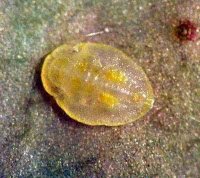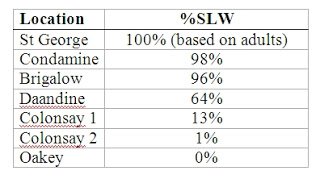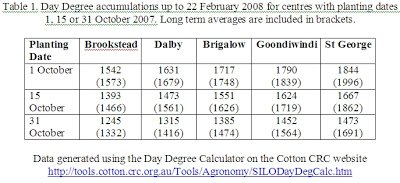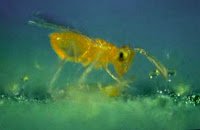
Which whiteflies are out there?
Results of whitefly samples identified from Downs cotton crops this week indicated variable incidence of SLW. In all cases except St George, identifications were based on immature (scale) stages used to differentiate Bemisia tabaci (SLW and Native Bemisia) from Greenhouse Whitefly (GHWF). These results infer that all Bemisia were SLW. Very few parasitoids were found in collections.

The Downs is considered a marginal area for problems with SLW because in an average season there is not enough heat and generally too few generations to create a problem. There is a perception that the 2007/08 season has been cooler than normal. Day Degree accumulations indicate that 2007/08 has been marginally cooler than average (see Table 1). Surprisingly, it has not been as cool as many have expected.
Management of SLW
Cotton crops are approaching the stage where decisions must be made on whether to control whitefly present in crops. Firstly it is important to know which whitefly is present. Is it SLW?
Given positive SLW identification, are they at levels that will present a problem later on in the crop cycle? To answer this question, careful monitoring of adult numbers is required.
Monitoring SLW infestations
Percentage infestation is based on a fixed sampling protocol, where a leaf is considered infested if 2 or more adult whiteflies are present. Full details of the sampling protocols and threshold values are available in the Cotton Pest Management Guide.
Control options
The objective of SLW control is to manage the population early to minimise exposure of open cotton to honeydew contamination.
Management options as defined by crop stage, accumulated Day Degrees and corresponding whitefly thresholds – include CONTROL, KNOCKDOWN and SUPPRESSION.
The CONTROL option involves application of an Insect Growth Regulator (IGR) and is appropriate for moderate to high densities after 1300 DD.
The KNOCKDOWN option involves application of conventional chemistry and may be used on low to moderate densities after 1600 DD to minimise contamination of lint from lower bolls.
Low to moderate densities after peak flowering (1300 DD) may also be treated with conventional chemistry for population SUPPRESSION so as to avoid the need for a later application of IGR.
Use of Insect Growth Regulators (IGRs)
- Where % infested leaves is consistently equal to or above the corresponding threshold value (> 1 adult/leaf after 1300 DD), use IGR from 1500 DD but no later than 1600 DD (first open boll).
- IGR – Pyriproxifen (Admiral®) – is highly effective against SLW, gives excellent control across a broad density range and is the corner stone of effective SLW management in cotton as it is also very selective, allowing survival of predators and parasites.
- Ensure only a single application of Admiral® occurs within a season.
-
Delaying the IGR application beyond 1600 DD and > 2 adults/leaf could result in yield loss, lower efficacy of the IGR, substantial lint contamination or all of the above.
Use of Conventional Chemistry
- Adult SLW densities of 0.5-1 adult/5th node leaf beyond 1600 DD (first open boll to leaf drop) are sufficient to contaminate lint from earliest open bolls.
- After first open boll (>1600 day degrees) and densities <>
- Single applications of Pegasus® or endosulfan (if window permits) used early (1300 – 1450 DD) on SLW densities <>
Natural enemies make an important contribution to the suppression of SLW when populations are low. Natural enemies include ladybeetles that will feed on scale, the parasitoid wasps, and probably a number of predatory bugs. However, their potential impact is not significant enough to be taken into consideration once the SLW population gets to the point that in-crop control (IGR application) decisions are being made.



Good information on the whitefly and the control options. Interesting – thought it would have been a much cooler summer.